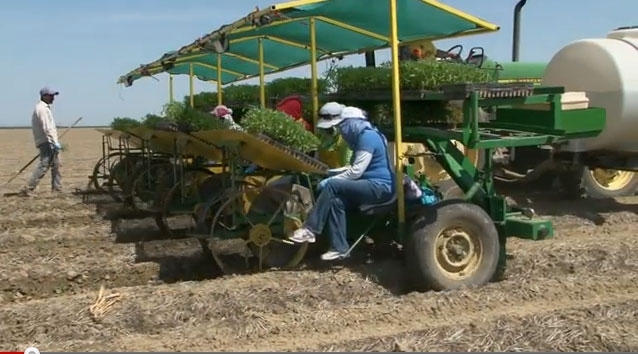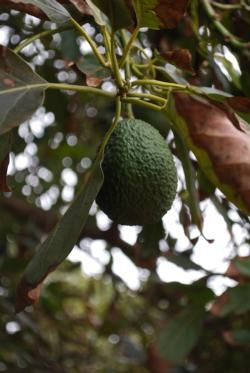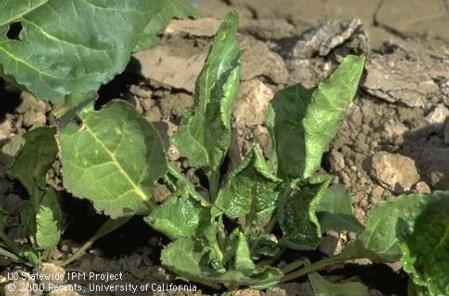Posts Tagged: Brenna Aegerter
New UC studies outline costs of growing tomatoes under furrow and sub-surface drip irrigation
Two new costs and returns studies for growing transplanted processing tomatoes under furrow irrigation and sub-surface drip irrigation (SDI) in the Sacramento Valley and northern delta are available from the University of California Cooperative Extension.
The studies focus primarily on production costs in the counties of Yolo, Solano, Sacramento and San Joaquin. The two separate studies list estimated production costs for growing transplanted processing tomatoes under furrow irrigation and under sub-surface drip irrigation on 60-inch beds.
The major differences between the two companion studies are inputs related to irrigation and tillage and from yield outcome.
Each analysis is based upon a hypothetical farm operation using practices common to the region. Input and reviews were provided by growers, pest control advisers and other agricultural associates. Assumptions used to identify current costs for individual crops, material inputs, cash and non-cash overhead are described. A ranging analysis table shows profits over a range of prices and yields. Other tables show the monthly cash costs, the costs and returns per acre, hourly equipment costs, and the whole farm annual equipment, investment and business overhead costs.
These two studies –“Sample Costs to Produce Processing Tomatoes, Sub-Surface Drip Irrigated (SDI) in the Sacramento Valley & Northern Delta - 2014” and “Sample Costs to Produce Processing Tomatoes, Furrow Irrigated in the Sacramento Valley & Northern Delta - 2014” – and other sample cost of production studies for many commodities are available and can be downloaded from the Agriculture and Resource Economics Department website, http://coststudies.ucdavis.edu. Some archived studies are also available on the website at http://coststudies.ucdavis.edu/archived.php
For additional information or an explanation of the calculations used in the study contact Karen Klonsky, UC Cooperative Extension specialist in the Department of Agricultural and Resource Economics at UC Davis, at (530) 752-3589, klonsky@primal.ucdavis.edu; or Don Stewart, staff research associate, (530) 752-4651, destewart@ucdavis.edu.
The studies were prepared by Gene Miyao, UCCE advisor, Yolo and Solano Counties; Brenna Aegerter, UCCE advisor, San Joaquin County; Karen Klonsky and Don Stewart.
Drought is forcing changes in California ag
California farmers are changing the way they grow avocados to deal with three distinct problems that are cutting into profits: rising fertilizer costs, spikes in water rates, and competition from avocados grown in Peru, Chile and Mexico, says University of California Cooperative Extension farm adviser Gary Bender. He was quoted in a story on Takepart.com about looming price increases for much-loved guacamole.
It takes 74 gallons of water to produce one pound of avocados — and drought-stricken California produces 95 percent of the avocados grown in the United States, wrote reporter Padma Nagappan.
Bender has been working with several farmers to experiment with high-density avocado planting, in which the trees are pruned to grow up rather than out. Growing more trees on less land will reduce water costs.
“The only way you can compete with cheaper imports and the high cost of water is if you go high-density and get more production per acre," said a San Diego area farmer.
An article in Growing Produce said the state has issued curtailments to some farmers who hold surface water rights. Because water rights law is so complex and because this is the first time many growers have had to navigate the finer details of water rights, Brenna Aegerter, University of California Cooperative Extension advisor in San Joaquin County, suggests that growers consult a professional for targeted advice.
Because of reduction in surface water availability, many growers are turning to groundwater to irrigate their crops. However, groundwater presents its own set of challenges, Aegerter says.
“There's a shallow water table but it's not good quality,” Aegerter says. “It's salty water. I think right now the main concern is what the water quality is going to be — whether it's going to be salty, and whether that will affect the crops.”
In the Westlands Water District, growers are using a combination of increased reliance on groundwater and fallowing for their water management plans, according to Tom Turini, UCCE advisor in Fresno County.
“The groundwater is lower quality than the district water — with levels of total dissolved salts and toxic ions varying from well to well — but generally higher than ideal, ” Turini says.
Crop diseases a concern in strawberries and tomatoes this year
Record reporter Reed Fujii spoke to Brenna Aegerter, UC Cooperative Extension advisor in San Joaquin County. She said she's never seen such losses due to beet curly top virus.
"In my eight years here in this county, I had only seen curly top in two fields," she said. "The virus was present in every tomato field I have seen this season, though in most fields, the incidence was so low as to not be a concern."
Beet curly top is spread by beet leafhopper. The insect don't like tomatoes and peppers, but will briefly feed on the crop and infect them before moving on, Aegerter said. The high leafhopper population is most likely a cyclic peak.
"The hope is we'll go back next year to not seeing it," Aegerter said.
Amy Asman of the Santa Maria Sun used UC Cooperative Extension materials for her story on the serious pallidosis-related disease threat in local strawberries. For detailed information about the strawberry decline, see UCCE advisor Surendra Dara's story in the Strawberries and Vegetables blog.
Growing pumpkins is like a beauty pageant
Commercial pumpkin production poses many of the same challenges as growing other gourds and squash plants, like cucumbers, luffas, zucchini and watermelons, wrote Reid Fujii in the Stockton Record.
Growers must watch out for overwatering, plant diseases, and pests like squash bugs and cucumber beetles, said Brenna Aegerter, UC Cooperative Extension advisor in San Joaquin County.
"Like one of the growers here told me, it's a beauty pageant," Aegerter said. "It's all about how they look; it's not how they taste."
While other states produce more pumpkins than California, particularly those grown for canning and pumpkin pies, the Golden State harvests the largest volume for the retail, fresh market, Aegerter said.

San Joaquin County leads the state in pumpkin production.
Late October rain a mixed bag for California ag
Rain and cool temperatures this week have prompted newspapers to see how the weather change is sitting with the state's agricultural industry.
The Woodland Daily Democrat reported that local rain and wind were good for some crops, and bad for others. The cool weather has postponed the harvest date for rice, while the rain has provided enough water for wheat to germinate, the story said.
UC Cooperative Extension farm advisor Kent Britton told reporter Katherine Jarvis farmers should wait until Nov. 1 to plant their winter wheat to avoid frost damage later in the season.
The Stockton Record reported that late winegrape varieties, tomatoes, almonds, walnuts, cut hay, beans, silage and grain corn, and rice are all taking a hit from the weekend rain. Meanwhile, the rain is a boon to cattle and sheep ranchers whose pastures are being watered.
UCCE viticulture advisor Paul Verdegaal told reporter Reed Fujii most of the Lodi area's 100,000 acres of vineyards have already been harvested.
"It's probably overall a little less damaging for the Lodi district than compared to the coastal and foothill areas, (where the harvests) are a little bit delayed," Verdegaal was quoted.
Fujii also spoke to UCCE vegetable crops advisor Brenna Aegerter. She said there could be rain-related problems with cannery and fresh market tomatoes.
"Usually there's a delay, so maybe they can't go into the field for several days," Aegerter was quoted. "Then when they get back in, you get fruit rot, when the fruit has been wet for a couple days."




